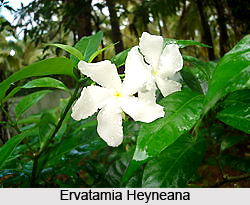 Ervatamia Heyneana is a plant which has lots of medicinal benefits. In Botany, this plant is known as Tabernaemontana heyneana Wall. It is named as `Nagarkuda` in Kannada, `Kundalapala` in Malayalam and `Pandrakura` in Marathi. Ervatamia heyneana is generally found in south-western India in open forests of the Western Ghats from Konkan (Maharashtra) southwards through Kerala up to 900 metre elevation.
Ervatamia Heyneana is a plant which has lots of medicinal benefits. In Botany, this plant is known as Tabernaemontana heyneana Wall. It is named as `Nagarkuda` in Kannada, `Kundalapala` in Malayalam and `Pandrakura` in Marathi. Ervatamia heyneana is generally found in south-western India in open forests of the Western Ghats from Konkan (Maharashtra) southwards through Kerala up to 900 metre elevation.
Characteristic Features of Ervatamia Heyneana
Ervatamia heyneana is a small deciduous tree and up to 9 metre tall with rough grey bark. The leaves of this plant are linear-oblong or lanceolate, 7.5 centimetres to 20 centimetres long and 2.5 centimetres to 7.5 centimetres wide. The apex shortly acuminate, base acute; main nerves are 12-16 pairs in number and petioles are 0.8 centimetres to 2 centimetres long. The flowers are white in colour, borne in stalked, many-flowered cymes; peduncles are 2.5 centimetres to 5 centimetres long; pedicels 1.3 centimetres to 2.5 centimetres long, buds clavate, rounded at the apex. Calyx 5 mm long, lobes are 2 mm long, broadly oblong with membranous margins; corolla tube 1.6 centimetres to 2.5 centimetres long, inflated near the top, limb 2.5 centimetres across when expanded with obtuse, crisped lobes overlapping to the right. The fruits are paired. It gets orange-yellow in colour when ripe, 1.2 centimetres to 3.2 centimetres long and 1 centimetres to 1.3 centimetres wide, sessile and slightly recurvated; the seeds contain two per follicle and are 8 mm long, surrounded by red pulp.
Medicinal Uses of Ervatamia Heyneana
In southern India, the species of Ervatamia heyneana is used medicinally as a substitute for `Tabernaemontana divaricata` which is a closely related and more widely distributed species. The acrid, bitter root is used as a local anodyne and chewed to relieve toothache. Rubbed into a thin paste of Ervatamia heyneana with water is often taken internally as a vermicide. This paste of the plant is also applied with limejuice to clear opacity of the cornea. Charcoal is prepared from the root and the milky juice of the leaves and this is vastly used to treat opthalmia. The juice of the flowers, mixed with oil, is applied externally to relieve the burning sensation in sore eyes. The mixture of the juice of the flowers and oil is rapidly used for relief of some skin diseases. The milky juice of the leaves is used as a cooling application for wounds and it also reduce inflammation.



















